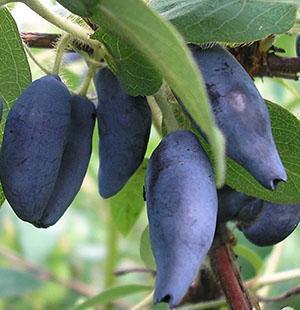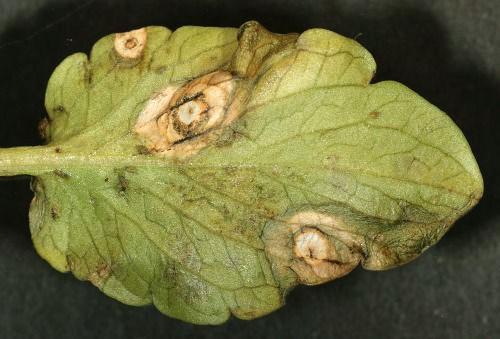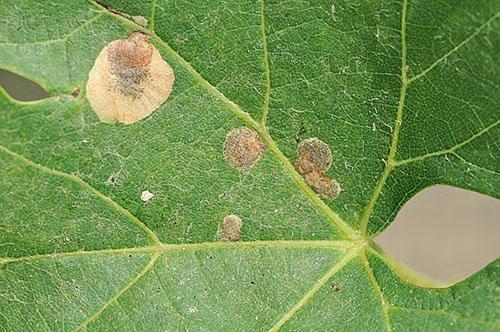We study photos and descriptions of diseases and pests of honeysuckle
 Both decorative varieties of honeysuckle and plants producing edible fruits are increasingly being attacked by pests and all kinds of diseases. The earlier opinion that a shrub with blue berries has no natural enemies turned out to be wrong. The spread of the culture in various regions of the country showed that not only people, but also insects, viruses and fungi, show interest in the shrub.
Both decorative varieties of honeysuckle and plants producing edible fruits are increasingly being attacked by pests and all kinds of diseases. The earlier opinion that a shrub with blue berries has no natural enemies turned out to be wrong. The spread of the culture in various regions of the country showed that not only people, but also insects, viruses and fungi, show interest in the shrub.
On this topic:tatar honeysuckle - photo, description!
If you do not worry about protecting the crop, the appearance of the plants deteriorates first, and then, due to the developing diseases of honeysuckle and the vital activity of pests, the yield is seriously affected.
Why does honeysuckle dry out with ramulariasis?

The shape of the spots can be either round or irregular. Moreover, over time, they grow, and the area affected by the disease of honeysuckle, like ramulariasis or spotting, expands. Ripe spores in the form of a white powder are crumbled several times during the growing season from the places where the fungus accumulates and are scattered on the root litter and healthy leaves. See honeysuckle honeysuckle photo.
The danger of the disease is not only that the crown of the honeysuckle dries up, and the plant weakens, but also in the ability of the spores to winter in the middle lane and settle again in the spring. Therefore, as a security measure:
- carefully remove the affected shoots;
- collect fallen old foliage;
- all parts of plants infected with the fungus are burned.
To protect the plant from the disease of honeysuckle of edible fungal origin, the treatment of bushes with fungicides, as well as copper sulfate, will help, bordeaux liquid or other preparations containing copper.
Cercosporosis - a dangerous disease of honeysuckle
 The answer to the question: "Why does honeysuckle dry?" often it becomes the detection of spots on the leaves, first having a dirty green tint, and then acquiring a brown or light gray color and a dark border along the edge. This is an obvious sign of the presence of Cercospora libicola fungi on the plant, which cause a dangerous honeysuckle edible disease cercospora.
The answer to the question: "Why does honeysuckle dry?" often it becomes the detection of spots on the leaves, first having a dirty green tint, and then acquiring a brown or light gray color and a dark border along the edge. This is an obvious sign of the presence of Cercospora libicola fungi on the plant, which cause a dangerous honeysuckle edible disease cercospora.
On healthy plants, fungal spores in the form of a dark powder come from the affected litter or already infected bushes.
Measures to combat cercosporosis are:
- in the collection and burning of fallen and already infected with fungus foliage;
- pruning shrubs in order to prevent their excessive density and better ventilation of the crown;
- regular plant nutrition mineral fertilizers;
- spraying before opening the buds and after picking the berries of the plantings and row spacings with Bordeaux liquid, cuprozan and fungicides.
Tuberculariosis, or drying of branches
 Already in June, darkening becomes noticeable, and then wilting and drying of foliage and individual shoots. Why does honeysuckle dry out in this case? The mushrooms that have settled on the fruiting bush - the causative agents of tuberculariosis - are to blame. Shoots affected by this disease of honeysuckle can be recognized by their characteristic red-brown tubercles, inside which spores mature, spreading to healthy branches and hibernating inside the shoots and on fallen diseased leaves.
Already in June, darkening becomes noticeable, and then wilting and drying of foliage and individual shoots. Why does honeysuckle dry out in this case? The mushrooms that have settled on the fruiting bush - the causative agents of tuberculariosis - are to blame. Shoots affected by this disease of honeysuckle can be recognized by their characteristic red-brown tubercles, inside which spores mature, spreading to healthy branches and hibernating inside the shoots and on fallen diseased leaves.
To prevent the disease:
- cut off and be sure to burn stems affected by fungi;
- in early spring and after flowering, the shrubs are treated with Bordeaux liquid.
Powdery mildew of honeysuckle
 The mushrooms, which are the cause of this disease of edible honeysuckle, form a white cobweb-like bloom on the shoots, the upper and lower surfaces of the leaves. Young branches are the first to suffer, but over time, the disease spreads to the entire plant. The leaves turn brown, dry up and fall off before the due date, similar processes take place on the shoots, where the bark first dries up, and then the branches themselves are deformed, the plant withers and noticeably weakens.
The mushrooms, which are the cause of this disease of edible honeysuckle, form a white cobweb-like bloom on the shoots, the upper and lower surfaces of the leaves. Young branches are the first to suffer, but over time, the disease spreads to the entire plant. The leaves turn brown, dry up and fall off before the due date, similar processes take place on the shoots, where the bark first dries up, and then the branches themselves are deformed, the plant withers and noticeably weakens.
It is possible to cope with the fungus wintering on the bark and thicker plant debris if you destroy fallen leaves and diseased branches, as well as treat bushes with sulfur-containing preparations at the first signs of honeysuckle disease.
Blackening of foliage and dying branches
 If spots of black plaque appear on the shoots and leaves of honeysuckle, which, without proper attention from the gardener, quickly expand and merge, then in this case it is mono to talk about the activity of mushrooms. As a result, at first the foliage looks "dirty", then it begins to dry out and fall off, and the activity of the causative agent of the disease, edible honeysuckle, can also affect the berries.
If spots of black plaque appear on the shoots and leaves of honeysuckle, which, without proper attention from the gardener, quickly expand and merge, then in this case it is mono to talk about the activity of mushrooms. As a result, at first the foliage looks "dirty", then it begins to dry out and fall off, and the activity of the causative agent of the disease, edible honeysuckle, can also affect the berries.
You can cope with the problem:
- timely pruning dry and damaged shoots;
- collecting and destroying affected foliage;
- in early spring, annually spraying the plants with an aga-peak or Bordeaux mixture and repeating the treatment after flowering.
Mottling leaves

Some types of soil nematodes can spread mottling of honeysuckle leaves, which is expressed in a change in the natural color of the foliage, the appearance of whitish streaks and spots on the leaf plates.
As a rule, treatment with chemicals before this disease of honeysuckle is powerless, so the affected shoots and individual plants are simply removed.
Mosaic Virus
 A disease caused by a virus and carried by nematodes is manifested in the fact that in newly rooted honeysuckle seedlings, internodes are sharply shortened, and uncontrolled growth of lateral shoots from axillary buds begins. The foliage does not develop, the plants wither and die.
A disease caused by a virus and carried by nematodes is manifested in the fact that in newly rooted honeysuckle seedlings, internodes are sharply shortened, and uncontrolled growth of lateral shoots from axillary buds begins. The foliage does not develop, the plants wither and die.
Control measures for this disease of honeysuckle include careful selection of planting material, as well as the mandatory destruction of shrubs with signs of the disease.
If in winter shoots of honeysuckle were damaged by frost, they must be cut out in a timely manner, otherwise the same fungi quickly settle and develop on the wound surface, causing the shoots to dry out and leaf fall.
Common pests of honeysuckle: photo and description

 Rose leaf roll - This is a small, heavily pubescent brown butterfly, whose caterpillars eat young foliage located on actively growing shoots. Sometimes from the pests of honeysuckle, in the photo, growth points suffer, and the damaged parts of the bush are combined into a dense lump covered with cobwebs.
Rose leaf roll - This is a small, heavily pubescent brown butterfly, whose caterpillars eat young foliage located on actively growing shoots. Sometimes from the pests of honeysuckle, in the photo, growth points suffer, and the damaged parts of the bush are combined into a dense lump covered with cobwebs.
 Honeysuckle fingerfly, or rather the caterpillar of this brownish or gray butterfly, penetrating deep into the ovary, eats not only the pulp, but also the seeds. This leads to a premature blue color of the fruit and their fall, which, with an abundance of pests, can seriously reduce the productivity of plants.
Honeysuckle fingerfly, or rather the caterpillar of this brownish or gray butterfly, penetrating deep into the ovary, eats not only the pulp, but also the seeds. This leads to a premature blue color of the fruit and their fall, which, with an abundance of pests, can seriously reduce the productivity of plants.
 Honeysuckle aphid - the most frequent, but always unwanted guest on the honeysuckle bush. During the season, at least two generations of this pest of honeysuckle may appear, a photo of which well reflects the massiveness of the defeat.
Honeysuckle aphid - the most frequent, but always unwanted guest on the honeysuckle bush. During the season, at least two generations of this pest of honeysuckle may appear, a photo of which well reflects the massiveness of the defeat.
The harm caused by adult aphids and their larvae is expressed in the weakening of shrubs due to the suction of juices from foliage and young shoots.
One of the most effective ways to combat aphids is the treatment of honeysuckle with infusion of tobacco dust with the addition of snail solution at the rate of 100 grams per 10 liters of water. A layer of liquid should cover all foliage and shoots affected by pests.To do this, spraying is carried out in dry weather and the bush is treated from all sides.

 Gooseberry moth - This is a motley large butterfly, laying eggs in the middle of summer, from which caterpillars feed on foliage and young shoots soon appear.
Gooseberry moth - This is a motley large butterfly, laying eggs in the middle of summer, from which caterpillars feed on foliage and young shoots soon appear.
 Willow and acacia scale insects - these are pests of honeysuckle, as in the photo, attaching to the shoots and sucking juices from them. As a result, the plant weakens greatly. Fruiting dies out, and after a while the bush dies.
Willow and acacia scale insects - these are pests of honeysuckle, as in the photo, attaching to the shoots and sucking juices from them. As a result, the plant weakens greatly. Fruiting dies out, and after a while the bush dies.
 Sometimes on the leaves of honeysuckle you can see winding stripes with a dried and pale surface. This is the result of the activity of larvae that develop from eggs laid in the thickness of the leaf plate by various types of miner flies.
Sometimes on the leaves of honeysuckle you can see winding stripes with a dried and pale surface. This is the result of the activity of larvae that develop from eggs laid in the thickness of the leaf plate by various types of miner flies.
 Making winding passages in the foliage and feeding on the sap of the plant, as in the photo, the honeysuckle pest interferes with the process of photosynthesis and slows down the growth of the shrub.
Making winding passages in the foliage and feeding on the sap of the plant, as in the photo, the honeysuckle pest interferes with the process of photosynthesis and slows down the growth of the shrub.
Treatment of honeysuckle bushes with chemical insecticides should be carried out in the form of small-drop irrigation and only in dry weather. A day or two after spraying, the effectiveness of the procedure is checked and, if necessary, re-treatment is carried out.
At the same time, we must not forget that the spring use of chemicals for edible honeysuckle is unacceptable, otherwise the ingress of toxic drugs on the ovaries cannot be avoided. In the fall, they must cut off and destroy all branches and foliage damaged by pests and diseases, including those already fallen.
Pink-lilac spots appear on the berries of honeysuckle. Is it some kind of disease?
To help you and your plant, you need a photo from the affected areas. it makes no sense to give any recommendations without preliminary diagnostics and you can harm the plant.
The honeysuckle fingerwing appeared in Irkutsk for the second season. What can be done and in what period so that this attack bypasses our site. People have all wormy honeysuckle, very scary.
Against the honeysuckle fingerwing, the bushes are treated with Inta-Vir. However, this must be done before flowering or after harvest. It is impossible to spray the honeysuckle with chemicals during the period when it already has fruits. You can try folk remedies, such as infusion of potato or tomato tops with the addition of soap (household).
Good day! I got sick with honeysuckle, rusty spots on the back of the leaves. Please help with advice!
honeysuckle is eaten along the trunk by a caterpillar, like a glass on a currant, what is it, and how to fight
Fight the caterpillar. It is especially raging this year. The Clean Garden complex works well.